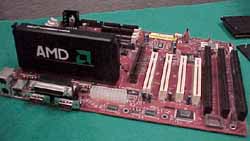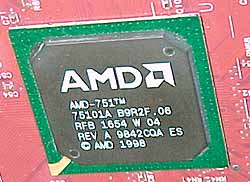
本人希望收购一些AMD SLOT1的CPU?
QQ:690530198 ntenter@gmail.com
谢谢
当时这类CPU倒是经常见到,现在要收藏反而没有了,郁闷!
呵呵 楼主不要把Slot1 和Slot A 混淆了
Slot1 是Intel的知识产权。SlotA是AMD模仿Intel的产物。
1G的真的很少见,我在本地留意n久了还是没有找到,只好前年低在淘宝上花100元包邮买的。
我这系列的各频率都有了[em01]
这个k7我也找了很久

[此贴子已经被作者于2010-1-13 11:57:17编辑过]
 图片附件: iY1mI4wF.jpg (2010-1-13 11:57, 169.41 KB) / 下载次数 1164
图片附件: iY1mI4wF.jpg (2010-1-13 11:57, 169.41 KB) / 下载次数 1164

如果能找到这种阿斯龙(K7)就好了


Around this time last year, ALi was the talk of the town because they were to be the first company to produce a Super7 chipset. After being shown up by VIA in the Super7 arena (especially in compatibility issues) and after quietly disappearing when their Slot-1 product was left unexposed, ALi has assumed a much quieter role this year and into the year 2000.
We saw no huge mention of support for the Athlon platform with ALi chipsets (although they did have a mockup of an Athlon board) and, other than the Aladdin TNT2 (Slot-1/Socket-370 chipset with integrated TNT2 core), there was only one new desktop chipset solution that ALi had in the works for a 2000 release, the Aladdin 7. The Aladdin 7 resembles an Aladdin TNT2 with a toned down GeForce for its integrated video as it does feature on-board hardware T&L. While we have yet to see any motherboards based on the Aladdin 7, the solution should provide an interesting low-cost, high-performance path into the gaming market. The combination of hardware T&L support and slower CPUs should make an Aladdin 7 based system an easy to afford entry level gaming machine.
[此贴子已经被作者于2010-9-4 14:37:48编辑过]
 图片附件: [AMD slot1的CPU怎么不见了?] 6dvFEytt.jpg (2010-1-13 14:31, 108.15 KB) / 下载次数 804
图片附件: [AMD slot1的CPU怎么不见了?] 6dvFEytt.jpg (2010-1-13 14:31, 108.15 KB) / 下载次数 804
 图片附件: ciyjMpDP.jpg (2010-9-4 14:35, 28.52 KB) / 下载次数 780
图片附件: ciyjMpDP.jpg (2010-9-4 14:35, 28.52 KB) / 下载次数 780
 图片附件: nhe9wGmK.jpg (2010-9-4 14:37, 20.97 KB) / 下载次数 790
图片附件: nhe9wGmK.jpg (2010-9-4 14:37, 20.97 KB) / 下载次数 790
如果能找到这种阿斯龙(K7)就好了
图里的工程版太养眼了。
还有,那种“7th Generation Processor”我有一个,很多人说着是QS的,不过我觉得那不一定是QS的。
如果能找到这种阿斯龙(K7)就好了
图里的工程版太养眼了。
还有,那种“7th Generation Processor”我有一个,很多人说着是QS的,不过我觉得那不一定是QS的。
羡慕ing...
我更相信是市场展示样品



 图片附件: [AMD slot1的CPU怎么不见了?] m5Pw6e2O.jpg (2010-8-20 13:42, 77.3 KB) / 下载次数 568
图片附件: [AMD slot1的CPU怎么不见了?] m5Pw6e2O.jpg (2010-8-20 13:42, 77.3 KB) / 下载次数 568
 图片附件: [AMD slot1的CPU怎么不见了?] ectp4aQx.jpg (2010-8-20 13:43, 93.61 KB) / 下载次数 566
图片附件: [AMD slot1的CPU怎么不见了?] ectp4aQx.jpg (2010-8-20 13:43, 93.61 KB) / 下载次数 566
 图片附件: [AMD slot1的CPU怎么不见了?] yqbQmmYY.jpg (2010-8-20 13:43, 98.73 KB) / 下载次数 572
图片附件: [AMD slot1的CPU怎么不见了?] yqbQmmYY.jpg (2010-8-20 13:43, 98.73 KB) / 下载次数 572
The Real Beauty of AMD - the K7
As mentioned above, I never expected to be able to see a live demo of AMD's upcoming K7 processor, however to my surprise, AMD had a first revision engineering sample of the K7 up and running in their suite at this year's convention, the results were beyond amazing.
For those of you that don't know, the K7 is an entirely new processor design from AMD, carrying over nothing more than the 3DNow! instruction set from the K6-2/3 predecessors, and abandoning the Socket-7 platform in favor of a slot-based design, called "Slot-A." While the processor is pin-compatible with Intel's Slot-1, architecturally, there is a universe of difference between the K7 and Intel's Pentium II. While the Pentium II uses the P6 bus architecture, AMD's K7 makes use of the Alpha EV6 bus protocol, which is theoretically more advanced than its Intel counterpart. The use of this EV6 protocol is much more than an attempt at rebellion by AMD against the restrictive hand of Intel, but it is also a much larger step towards advancement in technology.
Intended to compete directly with Intel's upcoming Katmai processor, the K7 will have to do much more than boast 3DNow! support to beat Intel at their own game. Comparing KNI (Katmai New Instructions, aka MMX2) to 3DNow! will become much more of an issue once the release date of the Katmai approaches, however now, very little information is available on KNI so any noticeable differences between the two technologies are unknown. One thing does exist in favor of AMD, 3DNow! has been and will be out for a much longer period of time than KNI at the release of both the Katmai and the K7, we'll have to wait and see if that has any effect on the outcome of the AMD/Intel wars of 1999.
|
The K7 will feature either 512KB or 1MB of L2 cache on the CPU cartridge itself, the stripped down processor looked much like the card inside of a Pentium II's casing, with one peculiar difference, the size of the K7 chip itself (not the card/cache) is about half of the size of the Pentium II's Deschutes core. |
 |
| In terms of L1 cache, the K7 will have a full 128KB of L1 cache, accounting for a noticeable percentage of its performance lead over an equivalently clocked Pentium II. | |
The K7 will run on a 200MHz EV6 bus and will be the first desktop AMD processor to support multiprocessing, a dream which may soon become reality. In terms of chipset development and support, AMD had their own design for a chipset solution at Comdex, codenamed "Gomez" which featured a North/Southbridge design similar to that of most VIA chipsets. According to AMD, at the launch of the K7 (officially Q2-99), both VIA and ALi should have chipset products ready for shipment and integration into motherboards for the K7.

|
The demo AnandTech was given featured a 500MHz K7, running at 200MHz x 2.5, with 64MB of PC100 SDRAM (the SDRAM was operated asynchronously to allow for the 200MHz FSB setting), on an AMD Gomez based Slot-A Motherboard, with a Diamond Fusion Z100 3Dfx Banshee video card (don't ask why they chose a Banshee, your guess is as good as mine). |
 |
| While AMD wouldn't allow AnandTech to obtain any benchmarks from the system, the performance seemed obviously superior to that of a Pentium II 450 in terms of the speed at which it completed Winstone, and 3D Winbench. The K7, if supported properly by motherboard manufacturers (an action that would be nothing but beneficial to manufacturers) can very well become the processor to get in 1999, even with the availability of the Katmai from Intel. | |
With that said, what could possibly be the downfall of the K7? AMD plans to release the K7 in a 0.25 micron version, then later make the transition to a 0.18 micron die size. If we think back to the initial die shrink from 0.35 micron down to 0.25 micron with the K6, numerous delays and yield problems tormented AMD and eventually led to an extremely late release of the highly anticipated K6/266. If the K6/266 had come out when it was announced in November of 1997, AMD would have had an extremely strong competitor against Intel's high priced Pentium II 300, unfortunately the die shrink down to 0.25 micron caused AMD more problems than they had bargained for, and it wasn't until 3 months later that the K6/266 finally hit the retail channels. AMD has a rocky road ahead of them if they plan to release the K7 in Q2 alongside Intel's Katmai, if they can, the consumer will have a huge advantage, as a true competitor to the Katmai should drive prices down incredibly at the launch of both processors leaving you all to choose either AMD or Intel for your next computer. If AMD can't however, it'll take much more than a K7-2 to pull AMD out of another delayed product


 图片附件: [AMD slot1的CPU怎么不见了?] c0RmbM6u.jpg (2012-1-17 13:12, 178.93 KB) / 下载次数 568
图片附件: [AMD slot1的CPU怎么不见了?] c0RmbM6u.jpg (2012-1-17 13:12, 178.93 KB) / 下载次数 568
 图片附件: [AMD slot1的CPU怎么不见了?] 0oR8XGyq.jpg (2012-1-17 13:12, 113.16 KB) / 下载次数 578
图片附件: [AMD slot1的CPU怎么不见了?] 0oR8XGyq.jpg (2012-1-17 13:12, 113.16 KB) / 下载次数 578
我的同样是没散热没风扇...
非常养眼的es.
AMD的u就是这样,市场反响好的都是些其貌不扬的,失败的东西都是西施潘安般的绣花枕头。
显然k7是个人见人爱的绣花枕头[em225]。
| 欢迎光临 硬件收藏论坛 (http://bbs.yjfy.com/) | Powered by Discuz! X1 |